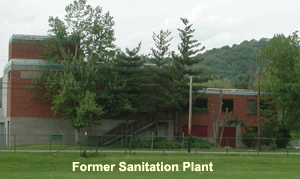
Bromley - Sanitation Plant
 In 1954, the Sanitation District No. 1 of Campbell and Kenton Counties constructed a large sewage treatment plant in the City of Bromley on Pike Street. From the time the plant was put into operation, the citizens of Bromley bitterly complained about the odors coming from the site. The situation became so tense, that on June 5, 1955, Judge Rodney G. Bryson, placed an injunction on the Sanitation District to cease operating the plant. The ruling directed that the plant could only reopen after the installation of odor-reducing equipment. The plant remained closed for over a year.
In 1954, the Sanitation District No. 1 of Campbell and Kenton Counties constructed a large sewage treatment plant in the City of Bromley on Pike Street. From the time the plant was put into operation, the citizens of Bromley bitterly complained about the odors coming from the site. The situation became so tense, that on June 5, 1955, Judge Rodney G. Bryson, placed an injunction on the Sanitation District to cease operating the plant. The ruling directed that the plant could only reopen after the installation of odor-reducing equipment. The plant remained closed for over a year.
In order to place pressure on the Sanitation District, the Bromley City Council refused to turn over their water meter records, thus, denying the district of billing Bromley residents. By May 1956, the necessary odor-reducing equipment had been installed at the plant. At this time the injunction was lifted and the Sanitation District sent employees to Bromley to read the water meters. When Bromley residents received their bills, they were shocked. Residents felt the bills were excessively high.
In June 1956, over 150 residents of Bromley met in the school building to discuss the situation. At this meeting, the Bromley Citizens Committee was established to represent the city in any future litigation with the Sanitation District. The following eight residents were elected to serve on the committee: Earl Ransom, Charles Bauer, Loraine Lambert, Dorothy Jennings, Ruth Ziegler, Robert Elliott, Mike Cross and James Callahan.
The new odor-reducing equipment installed at the plant in 1956 was not effective. In the summer of 1957, the citizens of Bromley sought an injunction on the plant. Little changed, and less than one year later, the odors from the plant were again reaching unacceptable levels.
The relationship between the sanitation plant and the citizens of Bromley remained tense for twenty-five years. To the great joy of Bromley, the facility was closed in 1979 when the Dry Creek Treatment plant was completed in northwestern Kenton County. In 1982, the facilities were transformed into the International Catfish Ranch.
Kentucky Times-Star, June 6, 1956, p. 1; News Enterprise, July 18, 1957, p. 1 and March 30, 1958, p. 1.
